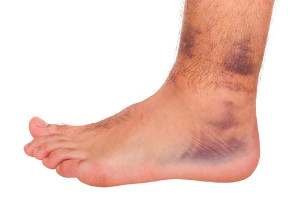
Many people sprain their ankles, and it can range from mild to severe. A common reason why people sprain their ankles is by suddenly stepping off of a step, or from falling and twisting it beyond its normal range of motion. Athletes may frequently experience this type of injury, which can happen as a result of running on uneven surfaces, or from landing awkwardly after jumping. Despite how painful an ankle sprain can be, the bone is not injured. The pain comes from ligaments that have become stretched too far, and may become partially or completely torn. There are two types of ankle sprains that can typically occur, and these are known as the inversion or eversion sprain. The former is considered to be the most common type of ankle sprain, and pain is felt on the outside of the ankle. Conversely, an eversion sprain happens when the ankle twists outward, causing pain on the inside of the ankle. If you have endured a sprained ankle, please consult with a podiatrist who can determine which type of sprain you have, and offer you relief and treatment options.
Although ankle sprains are common, they aren’t always minor injuries. If you need your ankle injury looked at, contact Leonora Fihman, DPM from California. Our doctor can provide the care you need to keep you pain-free and on your feet.
How Does an Ankle Sprain Occur?
Ankle sprains are the result of a tear in the ligaments within the ankle. These injuries may happen when you make a rapid shifting movement while your foot is planted. A less common way to sprain your ankle is when your ankle rolls inward while your foot turns outward.
What Are the Symptoms?
Preventing a Sprain
Treatment of a Sprain
In many cases, the RICE method (Rest, Ice, Compression, and Elevate) is used to treat ankle sprains. However, you should see a podiatrist to see which treatment option would work best with your injury. In severe cases, surgery may be required.
It is important to ask your doctor about rehab options after you receive treatment for your injury. Stretching, strength training, and balance exercises may help the ankle heal while also preventing further injury.
If you have any questions, please feel free to contact our offices located in Encino and Brentwood, Los Angeles, CA . We offer the newest diagnostic and treatment technologies for all your foot care needs.
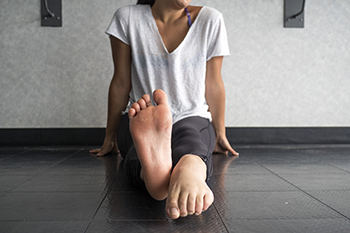
Every time you press your foot down on the accelerator of the car, nine muscles in your ankle, foot, and leg are used to accomplish this task. Additionally, very time you stand on tiptoe to reach something on a high shelf, you need these same muscles to help you to accomplish that. Dancers and many athletes, such as basketball and soccer players, depend on plantar flexion to extend their feet. This action is called flexing the muscles, and an injury to any of the muscles involved can make it painful and difficult to extend the foot. Ankle sprains and fractures are the main conditions that inhibit plantar flexion. When the ankle bones and muscles are injured, the result is swelling that reduces the range of motion. Three actions can help to prevent these types of injuries. First, it is beneficial to wear shoes that fit properly, and avoiding high heels which do not support the ankle. Secondly, perform exercises that strengthen those muscles in the legs, ankles, and feet which support plantar flexion. And lastly, consult a podiatrist who can provide you with tips on how to preserve ankle strength and support.
If you have any concerns about your feet, contact Leonora Fihman, DPM from California. Our doctor can provide the care you need to keep you pain-free and on your feet.
Biomechanics in Podiatry
Podiatric biomechanics is a particular sector of specialty podiatry with licensed practitioners who are trained to diagnose and treat conditions affecting the foot, ankle and lower leg. Biomechanics deals with the forces that act against the body, causing an interference with the biological structures. It focuses on the movement of the ankle, the foot and the forces that interact with them.
A History of Biomechanics
Modern technological improvements are based on past theories and therapeutic processes that provide a better understanding of podiatric concepts for biomechanics. Computers can provide accurate information about the forces and patterns of the feet and lower legs.
Understanding biomechanics of the feet can help improve and eliminate pain, stopping further stress to the foot.
If you have any questions please feel free to contact our offices located in Encino and Brentwood, Los Angeles, CA . We offer the newest diagnostic and treatment technologies for all your foot and ankle needs.
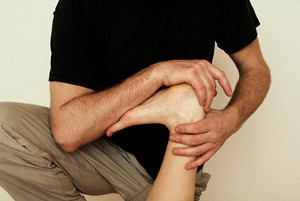
The feet are critical parts of the human body that require a lot of important attention and care to keep them functioning well. One important way in which individuals can keep their feet healthy and strong is to practice regular exercises and foot stretches. Different exercises can be performed for different purposes. For example, one might perform toe stretches to target and strengthen the toes. This can be performed by facing a wall and keeping the balls of the feet on the floor while letting the toes run up the wall. During this stretch, one might even be able to slightly bend the knees, deepening the stretch. This practice will effectively strengthen the toes. Of course, there are a variety of different exercises that can improve other parts of the feet. For example, an individual can perform calf stretches to improve flexibility and mobility. If you think that you might benefit from practicing foot exercises, contact a podiatrist today for specific foot stretches.
Stretching the feet is a great way to prevent injuries. If you have any concerns with your feet consult with Leonora Fihman, DPM from California. Our doctor will assess your condition and provide you with quality foot and ankle treatment.
Stretching the Feet
Being the backbone of the body, the feet carry your entire weight and can easily become overexerted, causing cramps and pain. As with any body part, stretching your feet can serve many benefits. From increasing flexibility to even providing some pain relief, be sure to give your feet a stretch from time to time. This is especially important for athletes or anyone performing aerobic exercises, but anyone experiencing foot pain or is on their feet constantly should also engage in this practice.
Great ways to stretch your feet:
Individuals who tend to their feet by regular stretching every day should be able to minimize foot pain and prevent new problems from arising.
If you have any questions, please feel free to contact our offices located in Encino and Brentwood, Los Angeles, CA . We offer the newest diagnostic and treatment technologies for all your foot care needs.
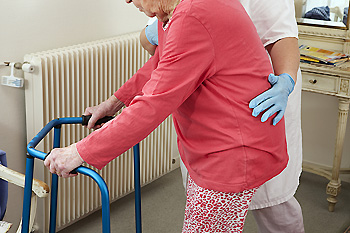
As an individual gets older they can become more susceptible to suffering from a detrimental fall. This might be caused by weakened foot muscles or neglect of caring for the feet. While senior citizens may experience falls in their homes or out shopping, seniors can also suffer falls at nursing care facilities too. It is estimated that approximately half of all elderly individuals in a long-term care environment fall each year. This is particularly helpful to be aware of because if you have a loved one in a long-term care facility, you might consider helping them take steps to care for and strengthen their feet so that they do not suffer a similar fate. Contact a podiatrist today for more information about preventing falls among seniors.
Preventing falls among the elderly is very important. If you are older and have fallen or fear that you are prone to falling, consult with Leonora Fihman, DPM from California. Our doctor will assess your condition and provide you with quality advice and care.
Every 11 seconds, an elderly American is being treated in an emergency room for a fall related injury. Falls are the leading cause of head and hip injuries for those 65 and older. Due to decreases in strength, balance, senses, and lack of awareness, elderly persons are very susceptible to falling. Thankfully, there are a number of things older persons can do to prevent falls.
How to Prevent Falls
Some effective methods that older persons can do to prevent falls include:
Falling can be a traumatic and embarrassing experience for elderly persons; this can make them less willing to leave the house, and less willing to talk to someone about their fears of falling. Doing such things, however, will increase the likelihood of tripping or losing one’s balance. Knowing the causes of falling and how to prevent them is the best way to mitigate the risk of serious injury.
If you have any questions, please feel free to contact our offices located in Encino and Brentwood, Los Angeles, CA . We offer the newest diagnostic and treatment technologies for all your foot care needs.

The development of corns on the feet can be an annoyance for a wide variety of individuals across the country. Typically this condition develops in response to the concentration of intense pressure or friction on the foot. The corn itself is made of thick skin. Importantly, there are steps that you might consider taking in caring for your corns. For example, wearing the correct kind of footwear can have a significant impact on the extent to which the corns are being taken care of. By wearing shoes that are ill-fitting, an individual can aggravate the corns. Instead, one might think about wearing shoes that provide the feet with sufficient space to move about in freely. Thus, by choosing to wear the right kind of shoes, a person can sufficiently guard against both the formation and aggravation of corns. If you think that you might have corns, contact a podiatrist today to learn more about what can be done to mitigate and treat the condition.
If you have any concerns regarding your feet and ankles, contact Leonora Fihman, DPM of California. Our doctor will treat your foot and ankle needs.
Corns: What Are They? and How Do You Get Rid of Them?
Corns can be described as areas of the skin that have thickened to the point of becoming painful or irritating. They are often layers and layers of the skin that have become dry and rough, and are normally smaller than calluses.
Ways to Prevent Corns
There are many ways to get rid of painful corns such as wearing:
Treating Corns
Treatment of corns involves removing the dead skin that has built up in the specific area of the foot. Consult with Our doctor to determine the best treatment option for your case of corns.
If you have any questions please feel free to contact our offices located in Encino and Brentwood, Los Angeles, CA . We offer the newest diagnostic and treatment technologies for all your foot and ankle needs.
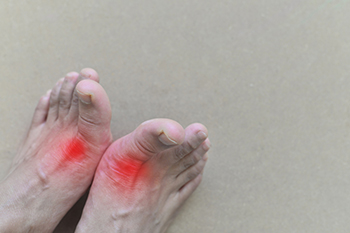
The foot condition known as gout can be potentially disabling, and completing daily activities is often difficult to do. It is considered to be a form of arthritis, and may target overweight men who are over 40 years old. Additionally, genetic factors and existing medical conditions, such as kidney disease, may contribute to developing gout. It can attack any of the toes, and generally begins in the big toe. It is an ailment that is caused by excess uric acid in the blood, which deposits in the joints of the toes in the form of crystals. Many people have said the pain can become so debilitating that it can be difficult to walk up the steps, and a lightweight sheet that is on top of the affected toe may cause excruciating pain. Gout attacks may be prevented by living a healthy lifestyle. This can include reducing the intake of red meat, alcohol beverages, sugary drinks, and shellfish. Additionally, it is beneficial to incorporate a gentle exercise program into your daily routine, and this may help to shed additional weight. If you have had gout one time or frequently, it is suggested that you are under the care of a podiatrist who can effectively treat this condition, and offer you helpful prevention tips.
Gout is a painful condition that can be treated. If you are seeking treatment, contact Leonora Fihman, DPM from California. Our doctor will treat your foot and ankle needs.
What Is Gout?
Gout is a form of arthritis that is characterized by sudden, severe attacks of pain, redness, and tenderness in the joints. The condition usually affects the joint at the base of the big toe. A gout attack can occur at any random time, such as the middle of the night while you are asleep.
Symptoms
Risk Factors
Prior to visiting your podiatrist to receive treatment for gout, there are a few things you should do beforehand. If you have gout you should write down your symptoms--including when they started and how often you experience them, important medical information you may have, and any questions you may have. Writing down these three things will help your podiatrist in assessing your specific situation so that he or she may provide the best route of treatment for you.
If you have any questions, please feel free to contact our offices located in Encino and Brentwood, Los Angeles, CA . We offer the newest diagnostic and treatment technologies for all your foot care needs.
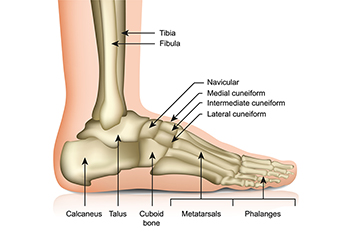
A stress fracture of the foot develops gradually, and the most common reason is from overuse. Each foot has 26 bones, and they endure the body’s weight. People who frequently run or participate in jumping activities may be prone to developing a stress fracture. It is considered to be a hairline fracture, and occurs at a weak point in the foot structure. Additional reasons why people may get stress fractures can consist of increasing speed and distance too quickly, or possibly from running on uneven surfaces. It is important to practice stretching techniques before running, and cooling down properly is essential. An X-ray is often taken which can provide a proper diagnosis. This is helpful in determining the severity of the fracture and is followed by treatment. Many patients use crutches to keep the weight off of the affected foot, which may help to accelerate the healing process. This can take up to eight weeks. If you are active in a particular sport and feel you may have a stress fracture, it is suggested that you schedule an appointment with a podiatrist who can effectively treat this condition.
Stress fractures occur when there is a tiny crack within a bone. To learn more, contact Leonora Fihman, DPM from California. Our doctor can provide the care you need to keep you pain free and on your feet.
How Are They Caused?
Stress fractures are the result of repetitive force being placed on the bone. Since the lower leg and feet often carry most of the body’s weight, stress fractures are likely to occur in these areas. If you rush into a new exercise, you are more likely to develop a stress fracture since you are starting too much, too soon. Pain resulting from stress fractures may go unnoticed at first, however it may start to worsen over time.
Risk Factors
Stress fractures do not always heal properly, so it is important that you seek help from a podiatrist if you suspect you may have one. Ignoring your stress fracture may cause it to worsen, and you may develop chronic pain as well as additional fractures.
If you have any questions, please feel free to contact our offices located in Encino and Brentwood, Los Angeles, CA . We offer the newest diagnostic and treatment technologies for all your foot care needs.

Cuboid syndrome is a condition of the foot that involves the cuboid bone. This bone is located on the outside of the foot and has a slightly cubical shape. If this bone moves out of alignment with the heel bone, this condition may develop. When determining how long it will take to recover from cuboid syndrome, it is important to consider several different relevant factors. Specifically, one’s recovery time from cuboid syndrome can depend on the duration of time in which the condition was present before treatment commenced. Additionally, recovery from cuboid syndrome can be influenced by the extent to which other injuries are present in the affected areas. One common injury includes ankle sprains. If such injuries are present, then recovery might last perhaps several weeks longer. Additionally, pain relief from cuboid syndrome often occurs within a few days. If you believe that you have cuboid syndrome, contact a podiatrist today.
Cuboid syndrome, also known as cuboid subluxation, occurs when the joints and ligaments near the cuboid bone in the foot become torn. If you have cuboid syndrome, consult with Leonora Fihman, DPM from California. Our doctor will assess your condition and provide you with quality foot and ankle treatment.
Cuboid syndrome is a common cause of lateral foot pain, which is pain on the outside of the foot. The condition may happen suddenly due to an ankle sprain, or it may develop slowly overtime from repetitive tension through the bone and surrounding structures.
Causes
The most common causes of cuboid syndrome include:
Symptoms
A common symptom of cuboid syndrome is pain along the outside of the foot which can be felt in the ankle and toes. This pain may create walking difficulties and may cause those with the condition to walk with a limp.
Diagnosis
Diagnosis of cuboid syndrome is often difficult, and it is often misdiagnosed. X-rays, MRIs and CT scans often fail to properly show the cuboid subluxation. Although there isn’t a specific test used to diagnose cuboid syndrome, your podiatrist will usually check if pain is felt while pressing firmly on the cuboid bone of your foot.
Treatment
Just as the range of causes varies widely, so do treatments. Some more common treatments are ice therapy, rest, exercise, taping, and orthotics.
If you have any questions, please feel free to contact our offices located in Encino and Brentwood, Los Angeles, CA . We offer the newest diagnostic and treatment technologies for all your foot care needs.
